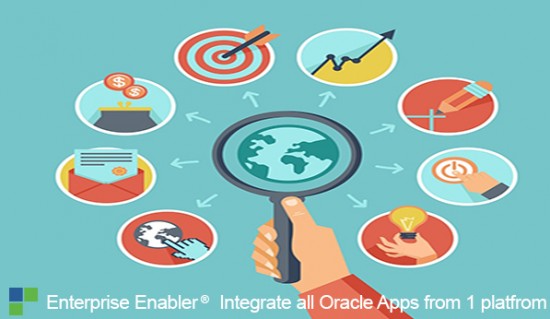Oracle Data Integration
Oracle Data Integration has become increasingly complex since the typical enterprise today runs multiple types of database management systems (DBMSs), such as Oracle and SQL Server, which weren’t designed to play well together. These systems are increasingly being used to store nontraditional types of information such as unstructured and semi-structured data.
Every enterprise usually has applications outside of the Oracle ecosystem that must be maintained and, better yet, integrated into Oracle platforms. Those applications can range from complex SAP business applications to in-house developed CRM or sales programs. Maximize analytics, data quality and privacy of all Oracle application integrations with Enterprise Enabler.
Quickly deliver Oracle Integration Configurations
- Exposes remote business functions and interfaces
- Supports bi-directional integration
- Interfaces directly with metadata and utilizes native business objects and functionality
- Real-time status reports and real-time interaction with Oracle jobs
- Read/write capability
- Access to multiple servers in one SQL request

Why purchase separate solutions to individual Oracle products?
IT operations that focus on the automation of business processes involve integrating a wide range of custom and enterprise applications and the infrastructure on which they run, often with complex interdependencies. In such environments, IT typically uses job scheduling tools to control batch and on demand event processing, which are vital to the success of a range of business operations from sales to manufacturing to financial management. Many organizations make the strategic decision to retain legacy applications and non-Oracle applications and solutions, even in the most widely deployed environments. That said, those investing in various Oracle technologies over the years have still been stuck in silos, with disparate applications and services divided by technological boundaries.
Synchronize data and automate business processes between Oracle and third party applications
AppComm Technology is the underlying engine that powers Enterprise Enabler to connect to any source-application, database, device, or standard- natively. Unlike traditional “adapters”, Stone Bond’s AppComms integrate from the source’s metadata layer, virtualize the metadata to allow for federation to unlimited sources for the most complex of integrations all in native, bi-directional format with full CRUD capabilities. The Active Integration Interface (Aii) of EE provides visual documentation of the entire process of data flows from source to target, all while tracking linage for compliance. Enterprise Enabler for Oracle protects performance and minimizes risk throughout the lifecycle of your Oracle E-Business Suite, PeopleSoft, Siebel, and JD Edwards applications. Whether upgrading, migrating, or integrating Oracle applications, with Enterprise Enabler data will remain clean, safe, connected and timely during any transformations.
![]()
Deliver faster ROI for Oracle applications
Stone Bond’s Oracle AppComm easily incorporates and manages ad hoc jobs submitted from multiple Oracle-defined jobs and even supports non-Oracle users who can input Oracle processes and run native Oracle jobs. The Oracle AppComm can define events that can be used for alerting and invoking an automated response, and dynamically introduce single jobs or entire workflow processes into a schedule when triggered by business events from a wide range of application adapters and platform-supported agents.
Access to multiple servers in one SQL request gives IT operations staff the ability to balance production and user-submitted jobs. Simplify job scheduling, reduce errors, and pinpoint potential issues with an enterprise-wide solution and more advanced scheduling functionality than the native Oracle scheduler. With Enterprise Enabler, Oracle users can have greater control over and visibility into the execution of their processes and understand their relationship with other technologies in the data center.
![]()

